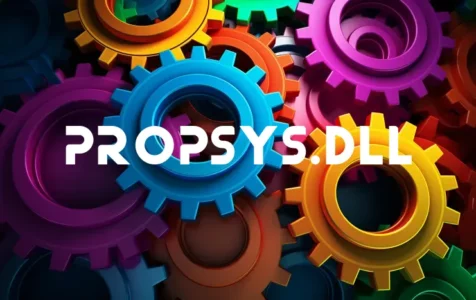PROPSYS.DLL is a Dynamic Link Library (DLL) file, which is a vital component of the Windows operating system. Created by Microsoft Corporation, this DLL file is associated with the Microsoft Property System, an extensive framework used primarily for indexing and searching files based on their properties, as well as handling file properties within Windows.
Is PROPSYS.DLL Safe and Could It Be a Virus or Malware?
Usually, PROPSYS.DLL is safe as it is a system file provided by Microsoft Corporation. It’s typically found in the C:\Windows\System32 directory, which is its standard location. However, if you find this file in a different location, it could potentially be a sign of a virus or malware disguised as a genuine DLL file.
Common Issues with PROPSYS.DLL
Errors related to PROPSYS.DLL may occur for several reasons. A common prompt you might encounter includes messages like “PROPSYS.dll error” or “PROPSYS.dll not found.” These errors often arise during computer startup, program startup, or while trying to use a particular function within your operating system. Issues could result from:
– Accidental deletion of the file.
– Faulty applications.
– Corrupted or damaged files likely caused by malware or virus attacks.
– Windows registry issues resulting from software uninstalls or application changes.
Expert Tip: For smoother PC performance, consider using a PC optimization tool. It handles junk files, incorrect settings, and harmful apps. Make sure it's right for your system, and always check the EULA and Privacy Policy.
Special offer. About Outbyte, uninstall instructions, EULA, Privacy Policy.
How to Fix Issues Associated with PROPSYS.DLL
Here are detailed instructions for resolving the most common PROPSYS.DLL related issues:
Restore from the Recycle Bin
If the PROPSYS.DLL file was accidentally deleted, it might still be in the Recycle Bin. To restore it, open the Recycle Bin, look for PROPSYS.DLL, right-click it, and select “Restore.”
Virus/Malware Scan
Run a thorough system scan with your antivirus or antimalware software to ensure that the system is not infected. If the scan doesn’t show any threats, or if removing them doesn’t solve the problem, try the other fixes.
Run System File Checker (SFC)
The built-in Windows tool SFC can fix corrupted system files, including PROPSYS.DLL. To run SFC:
1. Press “Windows key + X” and click on “Command Prompt (Admin)” or “Windows PowerShell (Admin).”
2. Type `sfc /scannow` and press Enter. The system will begin scanning and will attempt any necessary repairs.
Use DISM Tool
If SFC does not solve the issue, the Deployment Image Service and Management Tool (DISM) might be used to repair the Windows system image.
1. Open Command Prompt as an administrator.
2. Type the command `DISM /Online /Cleanup-Image /RestoreHealth` and press Enter.
Update Drivers
Outdated or corrupted drivers can cause DLL errors. Update your hardware drivers, especially if the error occurs when executing hardware-intensive tasks.
Windows Updates
Installing the latest Windows updates can replace or update missing or outdated DLL files.
1. Go to Settings.
2. Click on Update & Security.
3. Check for updates and install any pending updates.
Reinstall the Affected Programs
If a particular program is triggering PROPSYS.DLL errors, try reinstalling that specific application.
1. Open Control Panel.
2. Go to Programs and Features.
3. Uninstall the software that causes the error.
4. Download the latest version of the software and install it again.
Perform a Repair Installation of Windows
As a last resort before a complete reinstall, perform a repair installation. This will refresh your operating system files without affecting your personal files or installed programs.
– Get the Windows 10 installation media from the Microsoft website.
– Run the setup and select the upgrade option to repair installation.
Check for Hardware Issues
Rarely, hardware issues might cause DLL errors. Run a hardware diagnostic test provided by your computer manufacturer.
Still Need Help?
If none of the above steps work, it could indicate a deeper issue with your system. Consider consulting with a professional or reaching out for additional help in community forums where other users may have experienced similar problems.
Please note that it’s not recommended to download DLL files from the internet due to the risks of files being outdated or infected with malware. Always try to fix existing files or use official sources if you need to replace them.
Remember, dealing with system files can be risky; if you’re unsure about these steps or the results, it would be wise to seek professional assistance to prevent further system damage.
